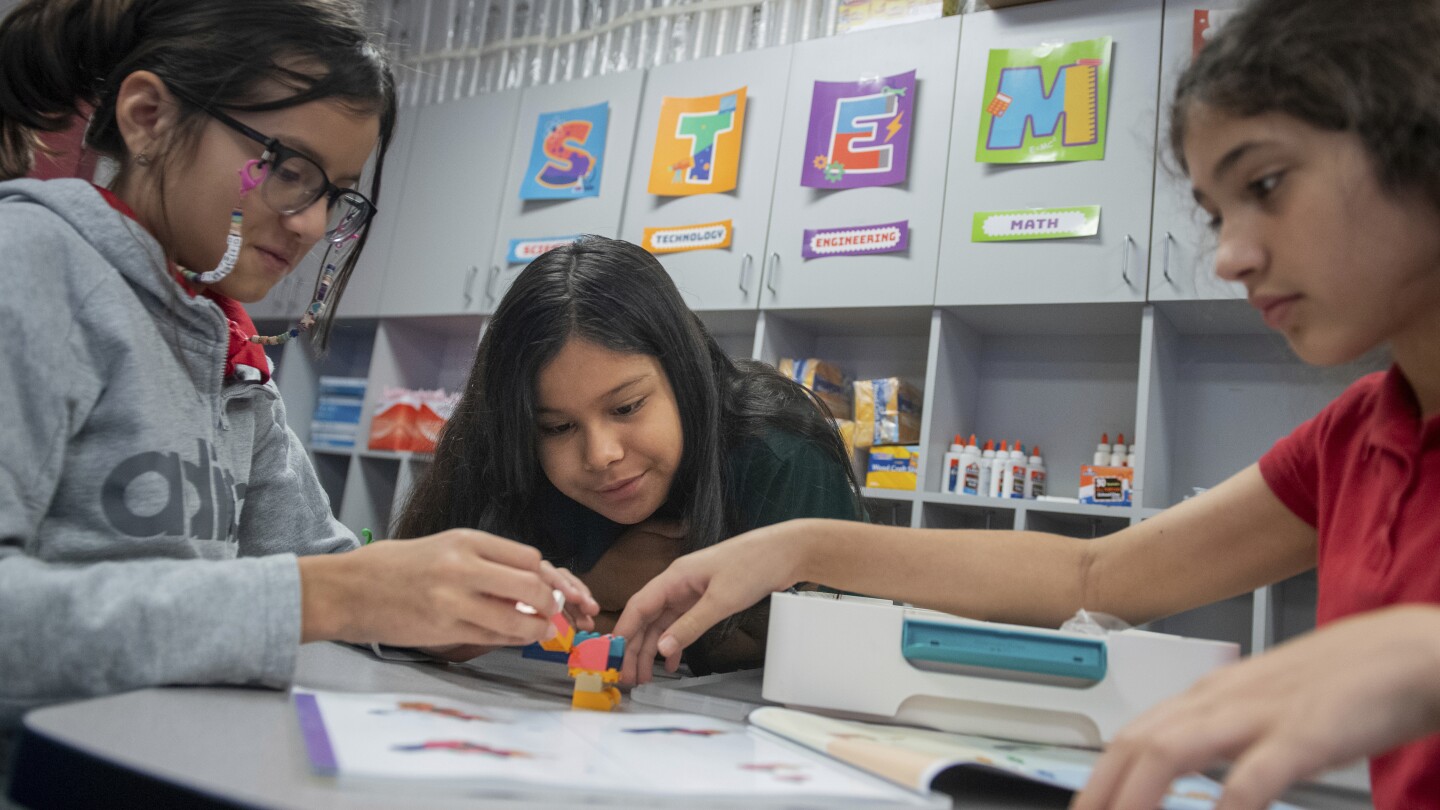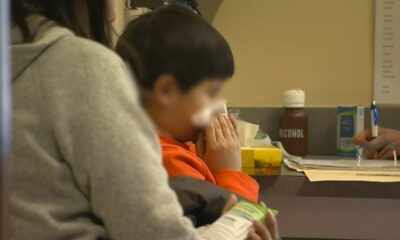Education
Schools Revitalize STEM Programs to Support Girls Post-Pandemic

The COVID-19 pandemic significantly impacted girls’ performance in mathematics, prompting schools to intensify efforts to engage female students in STEM (science, technology, engineering, and mathematics) programs. At de Zavala Middle School in Irving, Texas, a sixth-grade class has been intentionally structured to include a balanced ratio of girls and boys. This initiative aims to foster long-term interest among girls in STEM careers, countering a troubling trend that has emerged since the pandemic.
During a recent workshop, four girls worked diligently to troubleshoot a Lego machine they had built, demonstrating both curiosity and resilience. When their initial attempt to activate the machine with a purple card failed, they quickly adjusted by trying an orange card, leading to a successful outcome. “Oh! Oh, it reacts differently to different colors,” exclaimed sixth grader Sofia Cruz, capturing the excitement of discovery.
As schools nationwide grapple with the effects of the pandemic on educational equity, the gender gap in mathematics has widened. An analysis by the Associated Press revealed that while boys had historically scored higher on math tests, girls had made significant gains before the pandemic. By the 2023-2024 academic year, boys outperformed girls in math in nearly 90 percent of school districts. This reversal occurred after girls lost the progress they had made in test scores over the previous decade.
The pandemic disrupted learning and exacerbated existing biases, particularly in STEM fields. According to Michelle Stie, vice president at the National Math and Science Initiative, “When society is disrupted, you fall back into bad patterns.” With schools shifting to online learning, programs designed to engage girls in STEM were often sidelined, leading to a decline in interest and performance.
Addressing the Gender Gap in STEM
In the years leading up to the pandemic, educational practices increasingly emphasized flexible thinking and problem-solving, moving away from traditional rote memorization. Schools implemented research-backed methods that encouraged girls’ participation in STEM through hands-on learning experiences. However, the pandemic halted momentum, making it challenging to sustain these initiatives.
Superintendent Kenny Rodrequez of the Grandview C-4 District noted that girls often felt disengaged in STEM classes dominated by boys. To counter this, the district shifted introductory STEM lessons to earlier grades and balanced gender representation in classes. “Whenever there’s a crisis, we go back to what we knew,” Rodrequez remarked, reflecting on the need for renewed focus on equitable education.
The effects of the pandemic were not uniform across subjects. While girls experienced declines in STEM performance, they continued to excel in reading. According to research from NWEA, girls reported higher levels of anxiety and depression during the pandemic, which may have influenced their academic outcomes. Despite these challenges, girls maintained strong performance in non-STEM areas, indicating that the impact was particularly pronounced in science and mathematics.
Renewed Commitment to STEM Education
In response to the educational setbacks, de Zavala Middle School has reinforced its commitment to STEM education. Erin O’Connor, a STEM and innovation specialist, described the school’s efforts to rebuild a culture of inquiry and problem-solving. The introduction of a new science curriculum from Lego Education has been a central part of this initiative, allowing students to explore concepts such as kinetic energy through interactive lessons.
At Townley Elementary School, also in Irving, teacher Tenisha Willis exemplified the nurturing approach needed to encourage young girls in STEM. She guided her second graders through a project that involved building a machine to push blocks into a container. When one girl struggled with the design, Willis patiently encouraged her to think creatively and try different solutions. “Sometimes we can’t give up,” Willis reminded her students, reinforcing the importance of perseverance.
As schools work to recover from the pandemic’s educational disruptions, the focus on rebuilding girls’ confidence in STEM is more important than ever. With targeted initiatives and supportive teaching strategies, educators aim to inspire a new generation of female problem solvers and innovators.
-

 Technology5 months ago
Technology5 months agoDiscover the Top 10 Calorie Counting Apps of 2025
-

 Health3 months ago
Health3 months agoBella Hadid Shares Health Update After Treatment for Lyme Disease
-

 Health3 months ago
Health3 months agoErin Bates Shares Recovery Update Following Sepsis Complications
-

 Technology4 months ago
Technology4 months agoDiscover How to Reverse Image Search Using ChatGPT Effortlessly
-

 Technology1 month ago
Technology1 month agoDiscover 2025’s Top GPUs for Exceptional 4K Gaming Performance
-

 Technology3 months ago
Technology3 months agoElectric Moto Influencer Surronster Arrested in Tijuana
-

 Technology5 months ago
Technology5 months agoMeta Initiates $60B AI Data Center Expansion, Starting in Ohio
-

 Technology5 months ago
Technology5 months agoRecovering a Suspended TikTok Account: A Step-by-Step Guide
-

 Health4 months ago
Health4 months agoTested: Rab Firewall Mountain Jacket Survives Harsh Conditions
-

 Lifestyle5 months ago
Lifestyle5 months agoBelton Family Reunites After Daughter Survives Hill Country Floods
-

 Health3 months ago
Health3 months agoAnalysts Project Stronger Growth for Apple’s iPhone 17 Lineup
-

 Technology4 months ago
Technology4 months agoHarmonic Launches AI Chatbot App to Transform Mathematical Reasoning





















